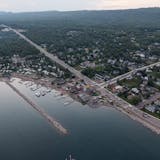The bad news continues for Minnesota's moose.
The population of the iconic animal in northeastern Minnesota has declined again, based on the latest aerial survey this winter by the Department of Natural Resources.
Wildlife researchers estimate that there are 5,500 moose in that region of the state. With a 23 percent margin of error, the estimate is not statistically different from last year's estimate of 7,600, but it supports other evidence that the moose population is declining.
"We don't believe the population dropped 2,000 in the past year, but it's indicative that the population is declining and parallels everything else we've been seeing," said Mark Lenarz, DNR wildlife researcher. "Our concern continues."
Reasons for the decline are uncertain, but researchers continue to believe a warming climate is responsible. Minnesota, already at the southern fringe of the moose range, apparently is becoming inhospitable for the large animals. Moose are extremely heat-sensitive, and temperature readings in Ely show over the past 48 years, average summer and winter temperatures have increased substantially.
Moose aren't likely to disappear anytime soon, but as their range shifts north, Minnesota's population could continue to stumble.
"People come up here to catch fish and see wildlife," said Bob Baker, owner of Gunflint Pines Resort and Campground on the Gunflint Trail, northwest of Grand Marais, Minn. "The moose is the one animal people want to see when they're here, and its decline could impact tourism."
Already in the northwest part of the state the number of moose has fallen from around 4,000 in the mid-1980s to around 100 today.


